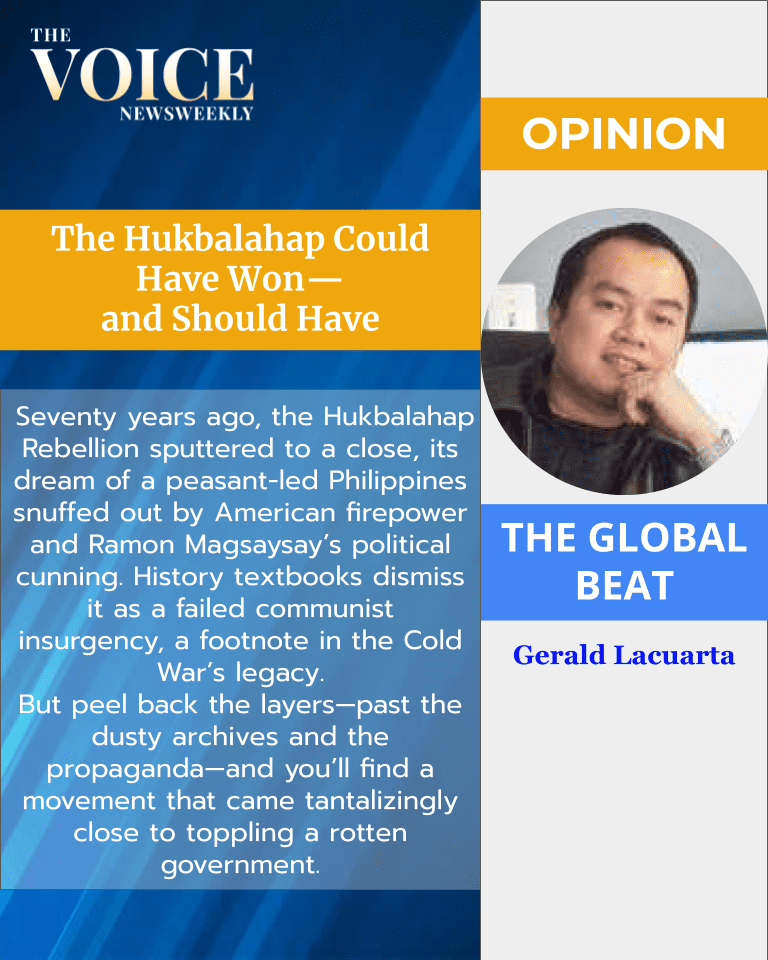𝗧𝗵𝗲 𝗚𝗹𝗼𝗯𝗮𝗹 𝗕𝗲𝗮𝘁 𝗯𝘆 𝗚𝗲𝗿𝗮𝗹𝗱 𝗟𝗮𝗰𝘂𝗮𝗿𝘁𝗮
The People’s Army That Almost Was
Central Luzon, February 25, 2025—Seventy years ago, the Hukbalahap Rebellion sputtered to a close, its dream of a peasant-led Philippines snuffed out by American firepower and Ramon Magsaysay’s political cunning. History textbooks dismiss it as a failed communist insurgency, a footnote in the Cold War’s legacy. But peel back the layers—past the dusty archives and the propaganda—and you’ll find a movement that came tantalizingly close to toppling a rotten government. The Huks weren’t just rebels with homemade guns; they were the raw, ragged voice of a peasantry trampled by centuries of landlord greed and colonial indifference. They lost, yes, but their defeat was no foregone conclusion. They could have won. And by every measure of justice, they should have.
I first stumbled across the Huks as a teenager, rummaging through my dad’s bookshelf in our Dau bungalow. There, wedged between old notebooks and desk references was Benedict Kerkvliet’s The Huk Rebellion, a red-covered paperback that smelled of mildew and promise. I was 15, more interested in music and games than history, but something about those pages hooked me: stories of barefoot farmers turned guerrillas, fighting not just Japanese invaders but the landlords who’d bled them dry for generations. Kerkvliet’s words painted a Philippines I didn’t recognize, one where the little guy almost won. That book planted a seed, and decades later, standing here in the shadow of Mount Arayat, I still believe the Huks’ story deserves a rewrite.
Let’s rewind to March 29, 1942, when the Hukbo ng Bayan Laban sa Hapon—the People’s Army Against the Japanese—was born in a bamboo grove near that very mountain. Under Luis Taruc’s steady gaze and the fiery rhetoric of old Communist Party (PKP) ideologues, some 30,000 peasants—armed with bolos, stolen rifles, and a grudge as old as the Spanish encomienda—swore to fight. They ambushed Japanese garrisons with ruthless precision, like the 1943 raid on Cabiao, Nueva Ecija, where a Huk squadron wiped out a platoon and seized enough ammunition to last months. By war’s end, they had killed thousands of enemy troops and collaborators, liberating swathes of Central Luzon. But their real triumph was quieter: a shadow government that collected rice taxes, settled disputes with makeshift courts, and handed stolen hacienda lands to tenants.
This wasn’t chaos. it was a glimpse of what might have been.
Then came the betrayal.
In 1945, as American liberators rolled in, they didn’t see the anti-Japanese Huks as allies. Instead, U.S. troops rounded them up. Some 109 Huks and peasants were massacred in Malolos, their bodies dumped like garbage. Meanwhile landlords who had collaborated with the Japanese reclaimed their estates. The Huks and peasantry felt betrayed.
The 1946 elections should’ve the been the Huks’ moment: Taruc and five other leftists won congressional seats, their ballots pushed mainly by blood and sweat of farmers. But the Liberal Party, propped up by Manila elites and Uncle Sam, barred them from Congress. That August, Juan Feleo, a local peasant hero and Huk negotiator, was dragged from a bus, murdered, and tossed into the Pampanga River. The government was nonchalant, so the Huks loaded their guns.
By 1950, they were a firestorm. Huk squadrons roamed Tarlac and Bulacan, torching police outposts and raiding armories. Their peak came that October, when 2,000 fighters struck simultaneously across Luzon, briefly seizing the town of Santa Cruz, Laguna, just 70 miles from Manila. The capital’s elites shivered in their Intramuros mansions as rumors spread of a march to Malacañang. President Elpidio Quirino’s army—riddled with corruption and led by officers more skilled at ballroom dancing than battle—floundered. The Huks had the numbers, the will, and the terrain: Central Luzon’s rice paddies and jungles were their fortress.
So why didn’t they win? The cracks showed early. Taruc, a farmer’s son with a poet’s heart, clashed with the PKP’s urban intellectuals, who dreamed of a textbook Marxist state. The 1949 ambush of Aurora Quezon (beloved widow of Manuel Quezon) killed her and 10 others on a Quezon Province road. The Huks blamed rogue fighters, but the stench of blood hurt their cause, turning churchgoers and merchants against them. Then came the Americans, alarmef by Korea’s fall to communism, pouring in $30 million and JUSMAG advisors with M-1 rifles. The Huks’ paltik shotguns couldn’t compete.
Enter Magsaysay, the game-changer. A former guerrilla with a lumberjack’s build and a common tao grin, he took the Defense helm in 1950 and turned the tide. He purged the army of dead weight, handed soldiers jeeps instead of desk jobs, and went to the barrios with promises: land for tenants, amnesty for rebels. His 1951 Nueva Ecija campaign (Operation Thunderbolt) caught 105 Huks in a single sweep, their hideouts betrayed by turncoats. By 1953, as president, he had shrunk the insurgency from 12,000 fighters to a weary 1,700. Taruc surrendered in ’54, broken not just by bullets but by exhaustion and a fractured dream.
But imagine a different script.
What if the Huks had patched their rifts in ’49, sidelining the PKP’s dogma for Taruc’s pragmatism? Picture them rallying Manila’s slum-dwellers—those taong masa ignored by Quirino’s cronies—alongside Visayan fishermen and Bicolano sharecroppers, forging a national uprising. Suppose they had dodged the Quezon ambush fiasco with tighter discipline, winning priests and teachers with tales of their wartime victories and rice handouts. A few smuggled crates of Soviet Kalashnikovs, slipped through Subic’s back channels during the Korean War, might have leveled the field. And if they’d taken out Magsaysay in ’51, Manila could’ve fallen by ’52.
The result? A Huk-led Philippines, rough-hewn but real. Taruc in Malacañang, not as a red stooge, but as a son of the soil, smashing the hacienda system that has choked us since Magellan’s day. Land reform—acres wrested from sugar and rice barons and given to the calloused hands that worked them—could have sparked an economy of smallholders, not oligarchs. No American bases dictating our wars, no puppet presidents bowing to Washington. It wouldn’t have been perfect (revolutions never are) but it might’ve been ours.
Skeptics will cry foul. Too messy, they’ll say. The Huks lacked the polish, the urban savvy, the global clout. The Quezon ambush was a PR disaster; their infighting, a death knell. And Magsaysay? A folk hero who outfoxed them fair and square. Maybe so. But revolutions aren’t won by polish—they’re won by grit. The Huks lost because they stumbled, not because their fight was unjust. Magsaysay’s victory—lauded as democracy’s triumph—propped up a system where landlords still reign and tenants still starve, a legacy we feel in 2025’s sprawling slums and gated estates.
Today, as the Pampanga River flows past fields still owned by the few, the
Hukbalahap’s ghost whispers a challenge: What if they’d won? A Philippines for the people, not the powerful, might have been their legacy.
We’ll never know but we should never stop asking.
__
Footnote: 𝑇ℎ𝑒 𝑎𝑙𝑡𝑒𝑟𝑛𝑎𝑡𝑒 ℎ𝑖𝑠𝑡𝑜𝑟𝑦 𝑝𝑟𝑒𝑠𝑒𝑛𝑡𝑒𝑑 𝑖𝑛 𝑡ℎ𝑖𝑠 𝑐𝑜𝑙𝑢𝑚𝑛 𝑖𝑠 𝑎 𝑠𝑝𝑒𝑐𝑢𝑙𝑎𝑡𝑖𝑣𝑒 𝑒𝑥𝑒𝑟𝑐𝑖𝑠𝑒 𝑒𝑥𝑝𝑙𝑜𝑟𝑖𝑛𝑔 𝑤ℎ𝑎𝑡 𝑚𝑖𝑔ℎ𝑡 ℎ𝑎𝑣𝑒 𝑏𝑒𝑒𝑛, 𝑏𝑎𝑠𝑒𝑑 𝑜𝑛 ℎ𝑖𝑠𝑡𝑜𝑟𝑖𝑐𝑎𝑙 𝑐𝑜𝑛𝑑𝑖𝑡𝑖𝑜𝑛𝑠 𝑎𝑛𝑑 𝑝𝑜𝑠𝑠𝑖𝑏𝑖𝑙𝑖𝑡𝑖𝑒𝑠. 𝐼𝑡 𝑑𝑜𝑒𝑠 𝑛𝑜𝑡 𝑎𝑑𝑣𝑜𝑐𝑎𝑡𝑒 𝑓𝑜𝑟 𝑜𝑟 𝑒𝑛𝑑𝑜𝑟𝑠𝑒 𝑎𝑛𝑦 𝑒𝑥𝑡𝑟𝑒𝑚𝑒 𝑖𝑑𝑒𝑜𝑙𝑜𝑔𝑦, 𝑝𝑜𝑙𝑖𝑡𝑖𝑐𝑎𝑙 𝑣𝑖𝑜𝑙𝑒𝑛𝑐𝑒, 𝑜𝑟 𝑡ℎ𝑒 𝑜𝑣𝑒𝑟𝑡ℎ𝑟𝑜𝑤 𝑜𝑓 𝑒𝑠𝑡𝑎𝑏𝑙𝑖𝑠ℎ𝑒𝑑 𝑙𝑒𝑔𝑎𝑙 𝑎𝑢𝑡ℎ𝑜𝑟𝑖𝑡𝑖𝑒𝑠 𝑜𝑟 𝑔𝑜𝑣𝑒𝑟𝑛𝑚𝑒𝑛𝑡, 𝑝𝑎𝑠𝑡 𝑜𝑟 𝑝𝑟𝑒𝑠𝑒𝑛𝑡. 𝑇ℎ𝑒 𝑎𝑢𝑡ℎ𝑜𝑟’𝑠 𝑖𝑛𝑡𝑒𝑛𝑡 𝑖𝑠 𝑡𝑜 𝑝𝑟𝑜𝑣𝑜𝑘𝑒 𝑡ℎ𝑜𝑢𝑔ℎ𝑡 𝑎𝑏𝑜𝑢𝑡 ℎ𝑖𝑠𝑡𝑜𝑟𝑖𝑐𝑎𝑙 𝑐𝑜𝑛𝑡𝑖𝑛𝑔𝑒𝑛𝑐𝑖𝑒𝑠 𝑎𝑛𝑑 𝑡ℎ𝑒𝑖𝑟 𝑚𝑜𝑑𝑒𝑟𝑛 𝑒𝑐ℎ𝑜𝑒𝑠, 𝑛𝑜𝑡 𝑡𝑜 𝑝𝑟𝑜𝑚𝑜𝑡𝑒 𝑎 𝑠𝑝𝑒𝑐𝑖𝑓𝑖𝑐 𝑎𝑔𝑒𝑛𝑑𝑎.














